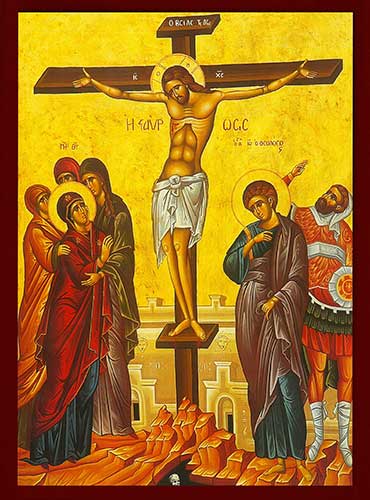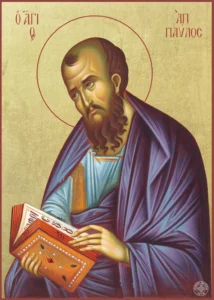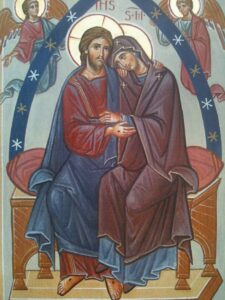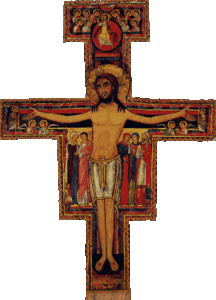The Only Mediator
Now, there is only one God, and only one mediator between God and men: Christ Jesus, himself human (1 Tim 2:5).
He is the mediator in His very being, because in His person He unites the two extremes of the mediation: God and man.
He is the mediator in all of His functions: no one else has given things so divine to men, and no one else has given things so profoundly and universally human to God. By means of Him, God gives Himself to man, and man gives himself to God.
Christ carried out all of the priestly offices, that is, all of “a priest’s duties,” as the Roman Pontifical states: “to offer sacrifice, to bless, to govern, to preach, and to baptize.”[1] However, the principal duty of the priest is to make an oblation, the offerre, the sacrifice. Thus, all of the priestly duties converge on the altar and derive from it, because every high priest is taken from among men and made their representative before God, to offer gifts and sacrifices for sins (Heb 5:1). His principal duty was to make the oblation of His Body and Blood, to sacramentally offer the sacrifice of the cross.
With this in mind, Bossuet said, “In the world there is no one greater than Jesus Christ, and there is nothing greater in Jesus Christ than His sacrifice.”[2]
There are four characteristics of the sacrifice of Christ:
- He offered the sacrifice of Himself.
- It is a unique sacrifice.
- It is a definitive sacrifice.
- It is an eternal sacrifice.
Christ Offered the Sacrifice of Himself
Seipsum offerendo: Christ had no need to offer sacrifices every day, as the other high priests did, first for their own sins and then for the sins of the people; rather, he did that once for all when he offered himself (Heb 7:27). As Christ said: Ecce venio (Heb 10:7). It was as though He said, “I know that it is impossible to take away sins with the blood of bulls and goats. . . . You have given Me a body; here You have it, do with it as You please, for by the death of this body the sins of this world will be taken away, sins that would remain without this death.”[3] So, when He came into the world, He said: Sacrifice and offering you did not desire, but a body you prepared for me (Heb 10:5).
His entire life paved the way to the cross; when His hour came, His sacrifice fulfilled the three necessary conditions of a real and efficacious sacrifice:
- The dedication or sanctification of the victim to God
- The voluntary oblation or offering
- God’s acceptance of the sacrifice
– The Dedication or Sanctification of the Victim to God
This is the act of consecrating the sacrifice, of separating it from profane uses. The ancients would pronounce “Sacer esto” (literally, “Be a sacred thing”) over the victim, separating it from the common destiny of all other things by an act of the priestly will.
In this way, the victim was dedicated to God, as though the priest said, “By an act of my will, I separate you from everything else, and I dedicate you to God.” Some say that the word sacerdos, priest, comes from this act, as the priest is “he who makes things sacred.” (Before the consecration of the bread and the wine, the priest extends his hands over them in a sign of sacrificial dedication).
Jesus Christ was the divine victim, consecrated for immolation by the heavenly Father who sanctified Him; He is the one whom the Father has consecrated and sent into the world, as a propitiatory victim for our sins (cf. Jn 10:36).
As the Priest, Christ sanctified Himself: I consecrate myself for them (Jn 17:19). He pronounced the words “Sacer esto” over Him-self in order that we might be sanctified by His death on the cross.
– The Voluntary Oblation or Oblation of Priestly Freedom
Jesus was the absolute owner of His life. With His priestly freedom He would offer His life in order to take it up again, and the Father loves Him for this reason: This is why the Father loves me, because I lay down my life in order to take it up again. No one takes it from me, but I lay it down on my own. I have power to lay it down, and power to take it up again (Jn 10:17-18). Many theologians, among them Saint Augustine, applied the following words, he offered prayers and suppl-cations with loud cries and tears to the one who was able to save him from death, and he was heard because of his reverence (Heb 5:7), to the immolation of the cross, and, in particular, to the loud cry (Mt 27:50, Mk 15:37, Lk 23:46). Still others argue that these words refer to the groans He expressed during His agony in Gethsemane, which, for our purposes, makes the same point.
God’s Acceptance of the Sacrifice
The Victim was supremely holy; He was none other than the only Son of God. The priest who offered the sacrifice was holy, innocent, undefiled . . . higher than the heavens (Heb 7:26). How could the Father not accept the Victim, if the Father Himself had pre-pared Him?
We know that Christ’s sacrifice was agreeable to the Father in a particular way because Christ entered into the tabernacle of heaven. But when Christ came as high priest of the good things that have come to be, passing through the greater and more perfect tabernacle not made by hands . . . he entered once for all into the sanctuary . . . with his own blood, thus obtaining eternal redemption (Heb 9:11-12).
B. It Is One Oblation, One Sacrifice, A Unique Sacrifice
No oblation like it has been seen in history, and neither will one be seen in the future that has all the specific characteristics of the cross. It was one in its object, in its internal form, in its efficacy, in its external form, and numerically.
– One in Object
In all other religions, the priests would rise to the altar in order to offer victims that were separate from themselves. In contrast, Jesus Christ is the only one who offered Himself, both on the ara[4] of the cross and on the ara of the altar. I am the good shepherd . . . and I will lay down my life for the sheep (Jn 10:14-15). Jesus is the Lamb of God, who takes away the sin of the world (Jn 1:29).
His broken Body shone as a body “placed on the cross, the al-tar of the world” (as Saint Leo the Great wrote, “Crux non templi ara, sed mundi”).[5] Christ is at once the one offering and the one offered, priest and oblation, altar and victim. As Saint Augustine said, “He is both the Priest who offers and the Sacrifice offered.”[6] It is an unprecedented novelty!
In all other sacrifices, the priest is separate from the victim, which is a substitute for sinners. Here, it is the Priest who is the substitute for sinners because He is also the Victim who offers Himself in sacrifice for them.
– One in Form
Christ did not Himself use the instrument that wrought His death, but rather His executioners did. His priestly weapon is love; love is the true priest who immolates Him. As an Easter hymn declares, “Amor sacerdos inmolat.” It was for love that the Lord went to His Passion. He suffered for love of me; He paid my debt for love of me. He died for love of me: the Son of God . . . has loved me and given himself up for me (Gal 2:20).
– One In Its Efficacy
The Old Testament sacrifices were ineffective; they were gifts and sacrifices that were not efficacious (cf. Heb 9:9) because it is impossible for the blood of bulls and goats to take away sin.[7] The high priest still had his conscience stained with sin, because the immense holocausts of victims sacrificed for sins cannot perfect the worshiper in conscience (cf. Heb 9:9). This is why Christ abolished the Levitic priesthood, the old sacrifices, the Mosaic Law, and the old covenant, which was annulled because of its weakness and uselessness, for the law brought nothing to perfection; on the other hand, a better hope is introduced (Heb 7:18-19).
Jesus Christ, in turn, offered a most efficacious and overflowing sacrifice: where sin increased, grace overflowed all the more (Rom 5:20). By the power of Christ’s blood, we have confidence of entrance into the sanctuary by the new and living way he opened for us through the veil, that is, his flesh (Heb 10:19-20).
– One In Its External Form
Sacrifices are usually offered in temples. Christ was offered outside of the temple and the city, outside the camp (Heb 13:13). No sacrifice appears as a punishment for some crime of the sacrificial victim; Christ, however, appeared as a man condemned to execution in order to pay for His own crimes by death. In reality, He was the Victim without stain of sin who carried upon Himself the sins of the whole world and who was, at the same time, the Eter-nal High Priest.
– One Numerically
Jesus Christ has no need, as did the high priests, to offer sacrifice day after day; he did that once for all when he offered himself (Heb 7:27). In other religions the supply of victims on the altar must be constantly renewed; in the Old Testament the sacrifices were constantly being reproduced. Jesus Christ, Priest and Victim, said: ‘Behold, I come to do your will.’ . . . By this ‘will,’ we have been consecrated through the offering of the body of Jesus Christ once for all . . . by one offering he has made perfect forever those who are being consecrated (Heb 10:9-14).
The Mass does not multiply the one sacrifice of Christ. What is multiplied are the distinct presences of the one sacrifice.
C. It Is the Definitive Sacrifice
There are four main reasons for this:
- It destroyed sin.
- It achieved its end.
- It makes an eternal covenant.
- We can actually unite ourselves to God by it.
– It Is Definitive because It Destroyed Sin
Only the definitive sacrifice of Christ ended the permanence of sin: Christ, offered once to take away the sins of many, will appear a second time, not to take away sin but to bring salvation to those who eagerly await him (Heb 9:28). It is this way because Christ took away the sins of those who take advantage of His redemption.
– It Is Definitive because It Achieved its End
Before Christ, sinners remained in their sinful state. Each year, on the Day of Atonement, the high priest had to repeat the same imposing ceremony.[8] This is not what happened with Jesus: For Christ did not enter into a sanctuary made by hands, a copy of the true one, but heaven itself, that he might now appear before God on our behalf. Not that he might offer himself repeatedly, as the high priest enters each year into the sanctuary with blood that is not his own (Heb 9:24-25). If Christ had not ended the reign of sin with only one sacrifice, He would have had to suffer many times, and suffer many times since the creation of the world. Rather, He manifested Himself only one time, in the fullness of time, for the destruction of sins by means of His sacrifice. In the same way that He established that men should die once and then be judged, so too will Christ, after having offered Himself once to take away the sins of the world, appear for a second time, without reference to sin, to those who await their salvation (Heb 9:26-28). He achieved His objective and made all subsequent efforts superfluous.
– It Is Definitive because It Made an Eternal Covenant
Christ’s sacrifice is the New Covenant, the New Testament. There will be no other covenant, just as there will be no other priesthood, no other sacrifice, no other law, and no further revelation. It is as the prophet Jeremiah announced: I will make a new covenant . . . It will not be like the covenant I made with their fathers (Heb 8:8-9; Jer 31:31-32). The New Covenant abolished the Old: When he speaks of a ‘new’ covenant, he declares the first one obsolete. And what has become obsolete and has grown old is close to disappearing (Heb 8:13).
Hours before, in an unbloody anticipation of the definitive sacrifice, the Author of the New Covenant put His sacramental Blood in the chalice, saying, This cup is the new covenant in my blood, which will be shed for you (Lk 22:20).
– It Is Definitive because Men Are Decisively Incorporated into God
This covenant is the reality. By the sacrifice of our Eternal High Priest, Jesus Christ, we have been decisively incorporated into the people of God the Father, constituted as members of the Mystical Body of Christ, and made temples of the Holy Spirit. This intimacy with God, this interchange between Creator and creature,[9] is possible because of the Mediator between God and men who sealed the New Covenant in His Blood: This is the covenant I will establish. . . . I will put my laws in their minds and I will write them upon their hearts. I will be their God, and they shall be my people. . . . All shall know me . . . and I will remember their sins no more (Heb 8:10-12, Jer 31:31-34). We were made members of His Body.
D. It Is an Eternal Sacrifice
Christ’s sacrifice is eternal because He has a priesthood that does not pass away (Heb 7:24).
The wonder of God’s love! Conserving the unity of His sacrifice without denying the hapax[10] (or in Latin semel, meaning one time or once), He found the way of reiterating His oblation with-out losing the unity of the sacrifice, the way of perpetuating the sacrifice throughout the world, enduring through the centuries, without it ceasing to be definitive. What a miracle of God’s love, a marvelous synthesis of miracles! Such is the Mass! By powers communicated to ministerial priests incorporated in His eternal priesthood, it is the same Priest who makes the sacrifice. It is the same sacrifice, the same Victim with His same Body and His same Blood; it is the same essential action that makes the same oblation.
Everything in the Mass is the same as on Calvary, except for the form of the offering: it is under an alien, that is, unbloody, species.
As the Body of Christ, offered in many places, is only one body, and not many bodies, so too is the sacrifice, offered in many places, only one sacrifice, and not many.[11]
It is the eternal sacrifice because Christ, consecrated priest by His Incarnation, will eternally offer the Father His sacrifice of adoration and thanksgiving, even until the end of the world.
He is the “living and immortal Victim.”[12]
In heaven, this High Priest, eternal according to the order of Melchizedek, the universal and enduring priest who offered the unique, definitive, and eternal sacrifice, celebrates His priestly ministry. We are called to prolong this sacrifice!
There, they celebrate the Eternal Feast of this unique priest and mediator, and they sing a new song, saying, ‘Worthy are you to receive the scroll and to break open its seals, for you were slain and with your blood you purchased for God those from every tribe and tongue, people and nation. You made them a kingdom and priests for our God, and they will reign on earth.’ I looked again and heard the voices of many angels who sur-rounded the throne and the living creatures and the elders. They were countless in number, and they cried out in a loud voice: ‘Worthy is the Lamb that was slain to receive power and riches, wisdom and strength, honor and glory and blessing.’ Then I heard every creature in heaven and on earth and under the earth and in the sea, everything in the universe, cry out: ‘To the one who sits on the throne and to the Lamb be blessing and honor, glory and might, forever and ever’ (Rev 5: 9-13).
[1] Pont. Rom. In Ordin. Praesb. Cited by I. Gomá, Jesucristo Redentor (Barcelona 1993) 185.
[2] J. Bossuet, Reflexiones sobre la agonía de Jesucristo; Cited by I. Gomá, Jesucristo Redentor (Barcelona 1993) 188.
[3] Cfr. Heb 10:5.
[4] Ara, Latin for altar, the usual site for the immolation of a sacrificial victim.
[5] Saint Leo the Great, Tract. septem et nonaginta; PL 1657, SL 138-138a, recension alpha, tract.: 59, line 131.
[6] The City of God, 10, 20.
[7] Cf. Heb 10:4.
[8] Cfr. Lev 16.
[9] Cfr. Heb 8:10-12.
[10] From the Greek word άπάξ, meaning once
[11] Cfr. Rom 12:5.
[12] Saint John Damascene, In Dominic. Pascha. Cited by I. Gomá, Jesucristo Redentor (Barcelona 1993) 200.







